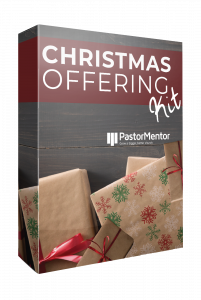
For most churches a well-executed Christmas offering will reap twice your normal weekly offering.
Think about it: that’s an extra 10% of your budget you can use for kingdom advancement.
If you’re like me, your mailbox is flooded in November and December with requests from every non-profit organization that has ever been lucky enough to get your contact info. These NGOs know that people feel more generous at Christmas than any other time of year.
Brad Formsma helps us understand this surge of generosity. He has written a great little book called I Like Giving: The Transforming Power of a Generous Life. He explains how giving benefits the giver:
Spending money on other people is powerfully life giving. It’s as if we’re created to give. Giving satisfies our most essential self, increases our happiness, and makes us feel more alive.
That life-giving happiness that flows from giving is in the air in December.
A veteran fund raiser once told me that people will donate to six causes at Christmas. Why shouldn’t your church be one of them? Your church can be on the receiving end of benevolence and generosity.
Here is a month-by-month timeline for a successful Christmas offering.
September
You only need to do two things to get a good start in September. First, decide on your project. What special need have you not been able to meet that you could fund this way? Choose something that people can see and feel, that is approximately equivalent to two weeks offerings, and give it a great name like One More Life or Project Hope.
Then order special Christmas offering envelopes.
October
It’s time to write the first letter to the congregation. Tell them about the project, why it’s necessary, and how they can participate.
This month you also want to get the first mailing ready to go out. The letter you just wrote goes to everyone in your church’s database. Include those who aren’t coming much. And especially include those who have moved away. Send a Christmas offering envelope along with your letter.
If your team likes to work ahead, they can get ready for the second mailing now, too.
The third thing to do in October is to set up a Christmas offering giving page on your website. You want people to be able to learn about the project, and to have the convenience of giving to the Christmas offering at any time and from any place.
November
Mail the letter you got ready last month on November 1st. You want your project to be among the first of the year-end requests in mailboxes.
Follow up the letter with an email a week later. Just send a short “I hope you’ll pray and consider” and a link to the web page so they have a second chance to read the letter you sent, and to see that they can donate online.
Write a second letter in November, and get the group together again to prepare the mailing. Include an offering envelope again. The second letter goes out in the middle of the month.
Be sure people are praying that God will nudge as the letters are received, that He will grow your congregation into mature givers, and that He will provide generously for the project.
December
To be heard above the din of December, you want to continue to communicate your message about the Christmas offering consistently. Each weekend, insert your Christmas offering envelope in your bulletin. Share a testimony or video about the need for the offering during the weekend services.
 On the weekend that is about ten days before Christmas, provide the opportunity for the church to give their offerings. You could simply announce it, and put baskets by the doors; or weave it into the message, and receive it as a second offering at the end of the service.
On the weekend that is about ten days before Christmas, provide the opportunity for the church to give their offerings. You could simply announce it, and put baskets by the doors; or weave it into the message, and receive it as a second offering at the end of the service.
Designate the Christmas Eve offering to go toward the special project, too. You will catch attenders who missed the earlier opportunity, and you will have guests who might be more inclined to give to a special project than the general fund.
Send a follow up email on the last day of the year thanking those who have given, and mentioning that they can still give online and get their tax deduction.
January and February
In early January you want to report the results and celebrate the amount that was given. Tell a story of someone who has already been helped by the offering.
You also want to write a personal thank you note to everyone who contributed to the offering. Distribute the note-writing if there are too many, but the pastor should personally write to all the major donors.
By February, report in church and by email on what has been done with the offering. Share a testimony or a video of the results.
Take some time in February to evaluate with other key leaders how the Christmas offering went, and what you want to do next year to improve its effectiveness.
Now What?
Be confident that a Christmas offering is all good. It teaches people to be generous; it frees up money for ministry; and it unleashes feelings of joy.
Start now to make plans for your Christmas offering this year.
Get a Christmas Offering Kit
 You’ll get everything you need to know to hold a successful Christmas offering including:
You’ll get everything you need to know to hold a successful Christmas offering including:
- how to choose a project
- what to say in the letters and emails
- dates to send them
- where you can get printed envelopes
- and what evaluation questions to ask.
See the Christmas Offering Kit!
 Hal Seed is the founding and Lead Pastor of New Song Community Church in Oceanside, CA. He mentors pastors who want to lead healthy, growing churches with resources at www.pastormentor.com.
Hal Seed is the founding and Lead Pastor of New Song Community Church in Oceanside, CA. He mentors pastors who want to lead healthy, growing churches with resources at www.pastormentor.com.
Start Here to learn more about the resources available for you at PastorMentor.
Leave a Reply